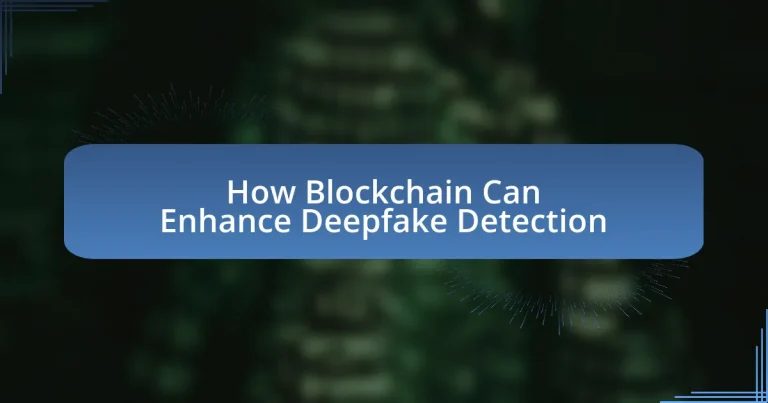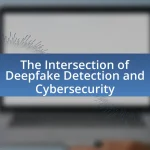Blockchain is a decentralized digital ledger technology that enhances the detection of deepfakes by providing a secure and immutable record of digital content. This article explores how blockchain’s key features—decentralization, immutability, transparency, and security—contribute to verifying the authenticity of media files, thereby improving trust in digital media. It also addresses the challenges and limitations of implementing blockchain for deepfake detection, including scalability issues and privacy concerns, while outlining best practices for effective integration. Additionally, the article highlights the ethical considerations and collaborative efforts necessary for successful deployment in combating misinformation and enhancing media integrity.
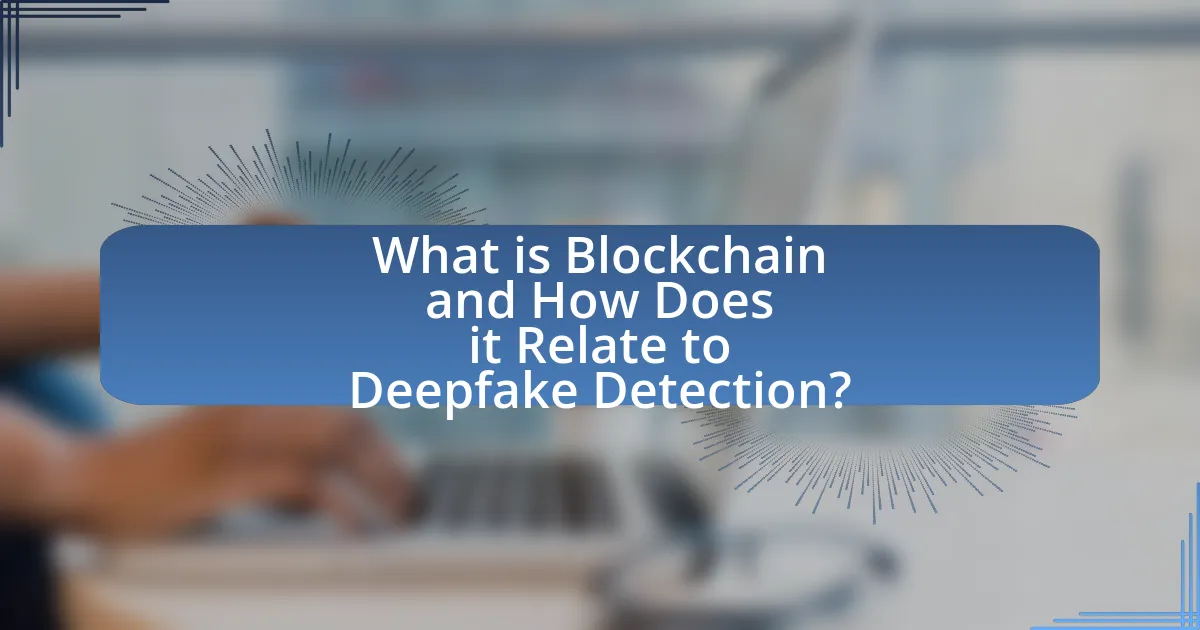
What is Blockchain and How Does it Relate to Deepfake Detection?
Blockchain is a decentralized digital ledger technology that securely records transactions across multiple computers, ensuring that the recorded data cannot be altered retroactively without the consensus of the network. In relation to deepfake detection, blockchain can enhance the verification of digital content by providing a transparent and immutable record of the origin and modifications of media files. This allows users to trace the authenticity of videos and images, making it easier to identify manipulated content. For instance, by embedding cryptographic hashes of original media files on a blockchain, any subsequent alterations can be detected, thereby improving trust in the authenticity of digital media.
How does blockchain technology function?
Blockchain technology functions as a decentralized digital ledger that records transactions across multiple computers in a way that ensures the recorded data cannot be altered retroactively. Each transaction is grouped into a block, which is then linked to the previous block, forming a chain. This structure is secured through cryptographic hashing, making it nearly impossible to change any information without altering all subsequent blocks, which requires consensus from the network participants. The decentralized nature of blockchain eliminates the need for a central authority, enhancing transparency and trust among users. According to a report by the World Economic Forum, blockchain can significantly improve data integrity and traceability, which is crucial for applications like deepfake detection, where verifying the authenticity of digital content is essential.
What are the key components of blockchain technology?
The key components of blockchain technology are decentralization, immutability, transparency, and security. Decentralization allows data to be distributed across a network of nodes, reducing the risk of a single point of failure. Immutability ensures that once data is recorded on the blockchain, it cannot be altered or deleted, providing a reliable historical record. Transparency enables all participants in the network to view transactions, fostering trust among users. Security is achieved through cryptographic techniques that protect data integrity and user identities. These components collectively enhance the reliability and trustworthiness of blockchain applications, including those in deepfake detection.
How does decentralization in blockchain enhance security?
Decentralization in blockchain enhances security by distributing data across a network of nodes, making it difficult for any single entity to manipulate or control the information. This distributed ledger technology ensures that all transactions are recorded on multiple nodes, which increases transparency and reduces the risk of fraud. For instance, in a decentralized system, altering a single record would require consensus from the majority of nodes, thereby protecting against unauthorized changes. Additionally, the cryptographic techniques used in blockchain, such as hashing and digital signatures, further secure the data by ensuring its integrity and authenticity.
What are deepfakes and why are they a concern?
Deepfakes are synthetic media created using artificial intelligence techniques, particularly deep learning, to manipulate or generate visual and audio content that appears real. They are a concern because they can be used to spread misinformation, damage reputations, and undermine trust in media, as evidenced by incidents where deepfakes have been employed in political campaigns and celebrity scandals, leading to significant social and ethical implications.
How are deepfakes created and manipulated?
Deepfakes are created using artificial intelligence techniques, primarily through deep learning algorithms that analyze and replicate facial features and movements. These algorithms, particularly Generative Adversarial Networks (GANs), consist of two neural networks: a generator that creates fake images and a discriminator that evaluates their authenticity. The manipulation process involves training these networks on large datasets of images and videos of the target individual, allowing the generator to produce realistic representations that can be seamlessly integrated into existing media. This method has been validated by numerous studies, including one published in the journal “Nature,” which highlights the effectiveness of GANs in generating high-fidelity images.
What are the potential impacts of deepfakes on society?
Deepfakes can significantly undermine trust in media and information, leading to misinformation and manipulation. The proliferation of deepfake technology has already resulted in instances of fake news, where altered videos have misled the public, as seen in the 2018 incident involving a deepfake video of a politician that went viral, causing public confusion. Additionally, deepfakes pose risks to personal privacy and security, as individuals can be depicted in compromising situations without their consent, which can lead to reputational damage and emotional distress. Furthermore, the potential for deepfakes to be used in cybercrime, such as identity theft or fraud, raises concerns about legal and ethical implications. Overall, the societal impacts of deepfakes include erosion of trust, increased misinformation, threats to privacy, and potential for criminal exploitation.
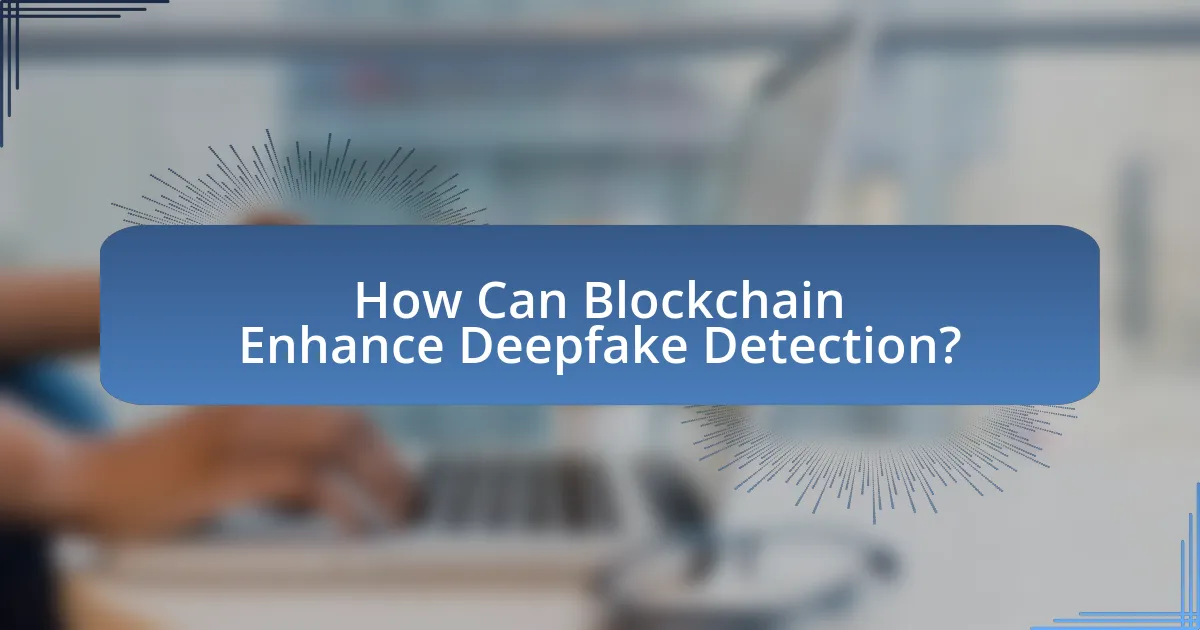
How Can Blockchain Enhance Deepfake Detection?
Blockchain can enhance deepfake detection by providing a secure and immutable ledger for verifying the authenticity of digital content. This technology allows for the creation of a transparent record of the origin and modifications of media files, making it easier to trace and validate the authenticity of videos and images. For instance, by embedding cryptographic hashes of original content on a blockchain, any alterations can be detected, as the hash will change if the content is modified. This method has been supported by research indicating that blockchain’s decentralized nature can significantly reduce the risk of manipulation, thereby improving trust in media authenticity.
What specific features of blockchain aid in deepfake detection?
Blockchain’s immutability and transparency are specific features that aid in deepfake detection. Immutability ensures that once data is recorded on the blockchain, it cannot be altered, allowing for a reliable audit trail of media provenance. This feature enables verification of the authenticity of digital content by tracing its origin and any modifications made over time. Transparency allows all participants in the blockchain network to access the same data, facilitating collaborative verification processes. For instance, if a video is registered on the blockchain, any subsequent alterations can be easily identified by comparing the current version with the original, thus enhancing the detection of deepfakes.
How does immutability contribute to verifying content authenticity?
Immutability contributes to verifying content authenticity by ensuring that once data is recorded on a blockchain, it cannot be altered or deleted. This characteristic allows for a permanent and tamper-proof record of content, which can be traced back to its origin. For instance, when a digital asset is created and logged on a blockchain, its unique hash serves as a digital fingerprint, enabling verification of its authenticity at any point in time. Studies have shown that blockchain technology can significantly reduce the risk of content manipulation, as evidenced by its application in various sectors, including supply chain management and digital media, where it has been used to authenticate products and verify ownership.
What role does transparency play in the detection process?
Transparency plays a crucial role in the detection process by ensuring that all actions and data involved are visible and verifiable. In the context of deepfake detection, transparency allows stakeholders to trace the origin of digital content, making it easier to identify alterations and verify authenticity. For instance, blockchain technology can provide an immutable ledger of content creation and modifications, which enhances accountability and trust in the detection process. This is supported by research indicating that transparent systems significantly improve the reliability of digital content verification, as they reduce the likelihood of manipulation and increase the confidence of users in the authenticity of the information presented.
How can blockchain improve trust in digital media?
Blockchain can improve trust in digital media by providing a decentralized and immutable ledger that verifies the authenticity of content. This technology enables creators to timestamp and register their digital media, ensuring that any alterations can be tracked and verified. For instance, a study by the University of California, Berkeley, demonstrated that blockchain can effectively authenticate digital assets, reducing the risk of misinformation and enhancing accountability. By utilizing smart contracts, stakeholders can establish clear ownership and usage rights, further reinforcing trust in the media ecosystem.
What are the implications of verified content on public perception?
Verified content significantly enhances public perception by fostering trust and credibility in information sources. When content is verified, it reduces the likelihood of misinformation, which can lead to more informed decision-making among the public. For instance, a study by the Pew Research Center found that 64% of Americans believe that misinformation has a major impact on their understanding of current events. This highlights the importance of verified content in shaping accurate public narratives and opinions. Furthermore, verified content can mitigate the effects of deepfakes, as blockchain technology can provide an immutable record of authenticity, thereby reinforcing the reliability of information and positively influencing public trust.
How can blockchain create a more reliable media ecosystem?
Blockchain can create a more reliable media ecosystem by providing an immutable ledger that verifies the authenticity of media content. This technology enables the tracking of content provenance, ensuring that users can trace the origin and modifications of media files. For instance, by timestamping and recording each interaction with a piece of media on the blockchain, stakeholders can confirm whether the content has been altered or remains original. Research indicates that using blockchain for media verification can significantly reduce the spread of misinformation, as it allows for transparent audits of content history, thereby enhancing trust among consumers and creators alike.
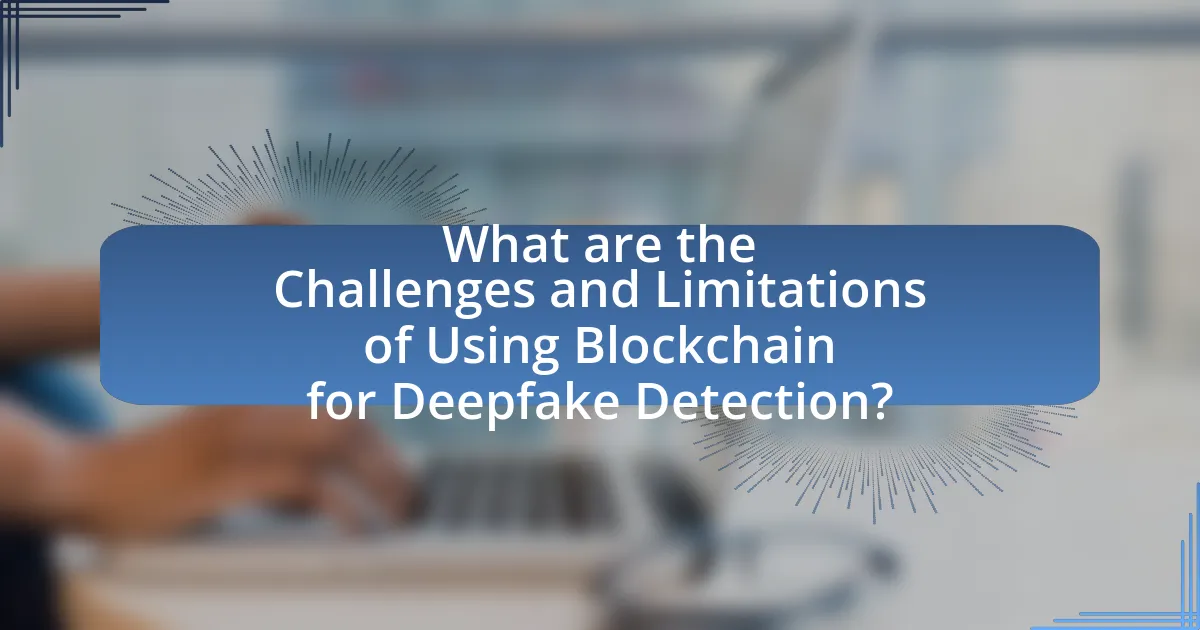
What are the Challenges and Limitations of Using Blockchain for Deepfake Detection?
The challenges and limitations of using blockchain for deepfake detection include scalability issues, high energy consumption, and the complexity of integration with existing systems. Scalability is a significant concern as blockchain networks can struggle to handle the large volume of data generated by deepfake content, leading to delays in processing and verification. High energy consumption arises from the consensus mechanisms used in many blockchain systems, which can be unsustainable and costly. Additionally, the complexity of integrating blockchain technology with current digital media frameworks poses a barrier, as it requires significant changes to existing workflows and may face resistance from stakeholders. These factors collectively hinder the effective implementation of blockchain for deepfake detection.
What technical challenges exist in implementing blockchain solutions?
Implementing blockchain solutions faces several technical challenges, including scalability, interoperability, and security. Scalability issues arise because many blockchain networks struggle to handle a high volume of transactions efficiently; for instance, Bitcoin processes about seven transactions per second, while traditional payment systems like Visa can handle thousands. Interoperability challenges occur as different blockchain platforms often lack the ability to communicate with one another, hindering the seamless exchange of data. Security concerns also persist, particularly regarding vulnerabilities in smart contracts, which can be exploited if not properly coded. These challenges must be addressed to effectively leverage blockchain technology in applications such as enhancing deepfake detection.
How do scalability issues affect blockchain applications in deepfake detection?
Scalability issues significantly hinder blockchain applications in deepfake detection by limiting the number of transactions that can be processed simultaneously. This limitation affects the ability to quickly verify and authenticate deepfake content, as the blockchain may become congested with data, leading to delays in processing and validation. For instance, Ethereum, a popular blockchain platform, can handle approximately 30 transactions per second, which is insufficient for real-time deepfake detection in high-volume scenarios. Consequently, the slow transaction speeds can result in outdated or irrelevant verification, undermining the effectiveness of blockchain as a reliable tool for combating deepfakes.
What are the potential privacy concerns associated with blockchain use?
The potential privacy concerns associated with blockchain use include the immutability of data, which can lead to the permanent storage of sensitive information, and the transparency of transactions, which may expose user identities and transaction details. For instance, while blockchain provides a secure and decentralized ledger, the public nature of many blockchains means that anyone can view transaction histories, potentially linking them to real-world identities. This transparency can compromise user anonymity, especially if personal data is inadvertently included in transactions. Additionally, regulatory compliance issues arise, as the General Data Protection Regulation (GDPR) mandates the right to be forgotten, which conflicts with blockchain’s immutable nature. These factors highlight the need for careful consideration of privacy when implementing blockchain technology.
What are the ethical considerations in using blockchain for deepfake detection?
The ethical considerations in using blockchain for deepfake detection include privacy concerns, data ownership, and the potential for misuse. Blockchain technology, while providing transparency and immutability, raises issues regarding the storage of personal data and consent, as individuals may not want their biometric data recorded on a public ledger. Furthermore, the ownership of the data used for deepfake detection can lead to disputes, especially if individuals are not adequately informed about how their data will be utilized. Additionally, there is a risk that the technology could be exploited for malicious purposes, such as creating false narratives or manipulating public opinion, which underscores the need for ethical guidelines and regulatory frameworks to govern its use.
How can we balance privacy and transparency in media verification?
To balance privacy and transparency in media verification, implementing decentralized blockchain technology is essential. Blockchain allows for the secure storage of verification data while maintaining user anonymity, ensuring that sensitive information is not exposed. For instance, by using cryptographic techniques, blockchain can verify the authenticity of media without revealing the identity of the individuals involved. This approach has been supported by research from the University of Cambridge, which highlights that blockchain can provide a transparent audit trail for media verification while protecting personal data. Thus, leveraging blockchain technology effectively addresses the dual needs of privacy and transparency in media verification.
What guidelines should be established for ethical blockchain use?
Guidelines for ethical blockchain use should include transparency, accountability, and user consent. Transparency ensures that all transactions and data are visible and verifiable, which is crucial in applications like deepfake detection where trust is paramount. Accountability mandates that all participants in the blockchain network are responsible for their actions, thereby reducing the risk of malicious activities. User consent emphasizes the importance of obtaining permission from individuals before their data is recorded or processed on the blockchain, aligning with privacy regulations such as GDPR. These guidelines are essential to foster trust and integrity in blockchain applications, particularly in sensitive areas like deepfake detection, where ethical considerations are critical.
What are the best practices for integrating blockchain in deepfake detection?
The best practices for integrating blockchain in deepfake detection include ensuring data integrity, enhancing traceability, and utilizing decentralized verification systems. Data integrity is achieved by recording original media files on a blockchain, which creates an immutable ledger that verifies authenticity. Enhancing traceability involves linking deepfake content to its source through blockchain timestamps, allowing users to track the origin and modifications of the media. Utilizing decentralized verification systems enables multiple stakeholders to validate content authenticity collaboratively, reducing reliance on a single authority and increasing trust in the detection process. These practices leverage blockchain’s inherent characteristics to improve the reliability and effectiveness of deepfake detection methods.
How can organizations effectively implement blockchain solutions?
Organizations can effectively implement blockchain solutions by first identifying specific use cases that align with their operational needs, such as enhancing data integrity and security in deepfake detection. They should then select an appropriate blockchain platform that supports smart contracts and offers scalability, such as Ethereum or Hyperledger. Following this, organizations must engage in thorough stakeholder collaboration to ensure that all parties understand the technology and its implications. Additionally, they should invest in training and development to build internal expertise in blockchain technology. Finally, organizations should conduct pilot projects to test the blockchain solution in a controlled environment, allowing for adjustments before full-scale deployment. This approach is supported by the fact that successful blockchain implementations often involve iterative testing and stakeholder engagement, as highlighted in various case studies across industries.
What collaborative efforts are necessary for successful deployment?
Successful deployment of blockchain for deepfake detection requires collaboration among technology developers, regulatory bodies, and industry stakeholders. Technology developers must work together to create interoperable systems that can effectively utilize blockchain for verifying content authenticity. Regulatory bodies need to establish guidelines that ensure compliance and protect user privacy while fostering innovation. Industry stakeholders, including social media platforms and content creators, must engage in partnerships to share data and best practices, enhancing the overall effectiveness of deepfake detection solutions. These collaborative efforts are essential to build a robust framework that addresses the challenges posed by deepfakes while leveraging blockchain’s transparency and security features.
